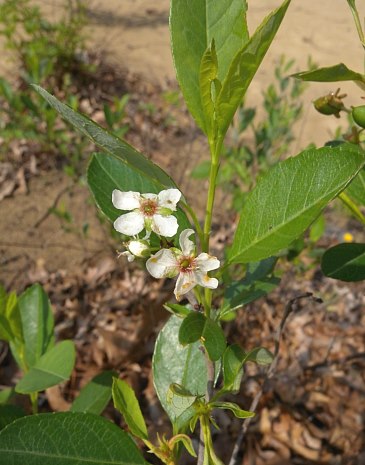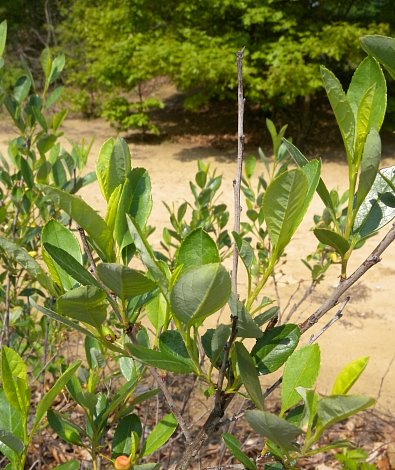
From the axils of the leaves, there occasionally develops small umbels of flowers. Individual flowers are about ½" across, consisting of 5 white spreading petals, a light green calyx with 5 lobes, 15-20 stamens, and a pistil with a style. The petals are larger than the lobes of the short-tubular calyx. The calyx lobes are oval-ovate in shape and minutely toothed along their margins. The blooming period occurs during late spring and lasts about 2 weeks. The flowers are replaced by drupes that are ovoid to globoid in shape, becoming about 1/3" (8 mm.) across and dark purple to black at maturity. Each drupe has juicy flesh and contains a single seed (pit or small stone). The root system is woody and branching.
Cultivation: The preference is full sun, dry conditions, and sandy soil. If this shrub is grown in moist fertile soil, it will become larger in size (up to 8' or more) than what normally occurs in its native habitat.
Range & Habitat: The native Susquehana Sand Cherry is restricted to northern Illinois, where it is uncommon. Habitats include dry sand prairies, inland sand dunes, and foredunes along Lake Michigan.
Faunal Associations: There is an abundance of information about floral-faunal relationships for cherry trees and shrubs (some Prunus spp.), but such information is very limited for the Susquehana Sand Cherry specifically. Some insect pollinators have been observed visiting the flowers of Sand Cherry (Prunus pumila); this includes Halictid bees (Lasioglossum spp.) and a butterfly, the American Painted Lady (Vanessa virginiensis); see Voss (1954) and Wilhelm & Rericha (2017. Undoubtedly many more pollinating insects visit this shrub, especially bees. Many kinds of insects feed destructively on various parts of cherry trees and shrubs, especially the larvae of moths. These species include the larvae of long-horned beetles (Cerambycidae), the Cherry Leaf Beetle (Tricholochmaea cavicollis), weevils, scarab beetles, the Eastern Cherry Fruit Fly (Rhagoletis cingulata), aphids, leafhoppers, larvae of several kinds of sawflies, larvae of tiger moths (Arctiidae), larvae of Geometer moths, the Eastern Tent Caterpillar (Malacosoma americanum), larvae of owlet moths (Noctuidae), larvae of prominent moths (Notodontidae), larvae of giant silk moths (Saturniidae), larvae of clear-winged moths (Sesiidae), larvae of Tortrix moths, larvae of ermine moths (Yponomeutidae), the Northern Walkingstick (Diapheromera femorata), and a thrips (Liothrips pruni). The Insect Table provides more information about these insects. Among vertebrate animals, many mammals eat the fruits. This include such species as the Gray Fox, Striped Skunk, Raccoon, American Black Bear, Eastern Gray Squirrel, Fox Squirrel, American Red Squirrel, and Eastern Chipmunk. The American Moose, Elk, and White-tailed Deer feed on the twigs and foliage of cherry trees and shrubs, while the Cottontail Rabbit strips the bark of saplings (Martin et al., 1951/1961; Schneider et al., 2006). The Deer Mouse and White-footed Mouse like to collect and feed on cherry pits (Whitaker, 1966; Houtcooper, 1978). In addition to mammals, many bird species eat the fruits of cherry trees and shrubs; some of these birds also eat their buds. They include such birds as the Cedar Waxwing, American Crow, Evening Grosbeak, Baltimore Oriole, Gray Catbird, Ruffed Grouse, Hairy Woodpecker, European Starling, Swainson's Thrush, American Robin, Eastern Kingbird, and Red-eyed Vireo. The Bird Table provides a more complete list of these species. Fruit-eating mammals and birds can disperse the seeds (pits) of cherry trees and shrubs for considerable distances into new locations.

Photographic Location: An inland sand dune at the Oak Openings Metropark in NW Ohio.
Comments: In addition to the scientific name that is used here, this shrub has been referred to as Prunus susquehanae, Prunus pumila cuneata, and Prunus cuneata. Other common names that refer to this shrub include Sand Cherry, Susquehana Cherry, and Appalachian Cherry. Compared to the typical variety of Sand Cherry, Prunus pumila pumila, Susquehana Sand Cherry has wider leaves with more obtuse tips. Another variety of Sand Cherry, Prunus pumila depressa, is a low sprawling plant only 1-2' tall that is found along sandy beaches. Of these different varieties, only the Susquehana Sand Cherry (Prunus pumila susquehanae) has been found in Illinois.